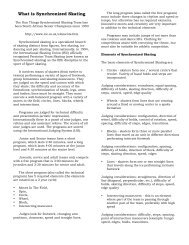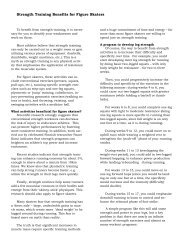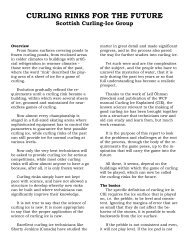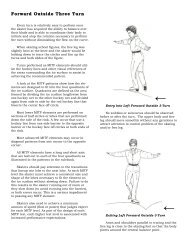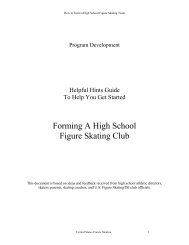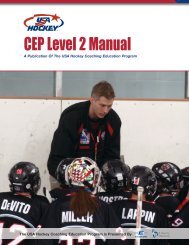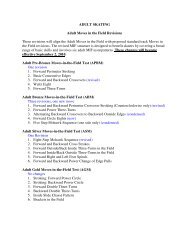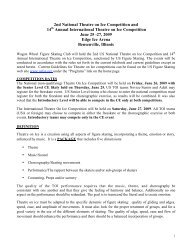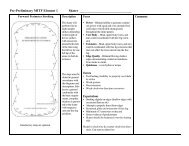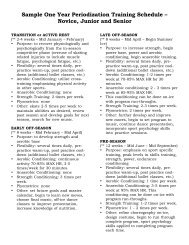Effects of Mood on Performance - American Board of Sport Psychology
Effects of Mood on Performance - American Board of Sport Psychology
Effects of Mood on Performance - American Board of Sport Psychology
You also want an ePaper? Increase the reach of your titles
YUMPU automatically turns print PDFs into web optimized ePapers that Google loves.
eginning state (equilibrati<strong>on</strong>). Thus, mood-disequilibrati<strong>on</strong> effects appear as fluctuati<strong>on</strong>swith peaks occurring before sport performances. Activati<strong>on</strong> as well as arousal are positedto decrease after competiti<strong>on</strong> according to the dis- and equilibrati<strong>on</strong> effects. The dis- andequilibrati<strong>on</strong> effects are expected to be unrelated to the results and level <str<strong>on</strong>g>of</str<strong>on</strong>g> performanceand the kind <str<strong>on</strong>g>of</str<strong>on</strong>g> sport.While inspecting the effect <str<strong>on</strong>g>of</str<strong>on</strong>g> moods up<strong>on</strong> athletic performance Rowley et al.(1995) found limited use <str<strong>on</strong>g>of</str<strong>on</strong>g> the Pr<str<strong>on</strong>g>of</str<strong>on</strong>g>ile <str<strong>on</strong>g>of</str<strong>on</strong>g> <str<strong>on</strong>g>Mood</str<strong>on</strong>g> States (POMS; Morgan, 1985; Morgan etal., 1988) in differentiating between successful and unsuccessful athletes whereas Terry(1995) indicated that scores <strong>on</strong> the POMS were capable <str<strong>on</strong>g>of</str<strong>on</strong>g> differentiating betweensuccessful and unsuccessful top-level athletes. Renger (1993) claims that in the study byMorgan and Pollock (1977) the POMS did successfully differentiate athletes from then<strong>on</strong>athlete norms, but was unable to differentiate athletes <str<strong>on</strong>g>of</str<strong>on</strong>g> differing levels <str<strong>on</strong>g>of</str<strong>on</strong>g> ability(see also Beedie, Terry & Lane, 2000; LeUnes & Burger, 2000; Prapavessis, 2000; Terry,2000). Furthermore, Terry & Lane (2000) proposed that the iceberg was a redundantc<strong>on</strong>cept as the normative mood pr<str<strong>on</strong>g>of</str<strong>on</strong>g>ile is an “iceberg”. These mixed findings may be duein part to the fact that the POMS does not measure calmness directly but neverthelesssome investigators infer calmness from a low tensi<strong>on</strong> score. However, Barkh<str<strong>on</strong>g>of</str<strong>on</strong>g>f andHeiby (2004b) reported no significant mood differences between competitor type andtraining champi<strong>on</strong> athletes in highlight sport competiti<strong>on</strong>. The method employed in theirstudy assessed mood <strong>on</strong>ly <strong>on</strong>ce before and after training as well as before and aftercompetiti<strong>on</strong>.While some results evaluating the predictability <str<strong>on</strong>g>of</str<strong>on</strong>g> athletic success based up<strong>on</strong> moodare mixed, overall there is str<strong>on</strong>g prospective evidence for the relati<strong>on</strong> between mood andsports performance (Cockerill et al., 1991). Findings may be mixed because mood has notbeen measured sensitively (see Lowther & Lane, 2002) and because both trainingchampi<strong>on</strong> and competitor types <str<strong>on</strong>g>of</str<strong>on</strong>g> athletes are combined (Morgan & Johns<strong>on</strong>, 1978;Rowley et al., 1995). Given the dynamic nature <str<strong>on</strong>g>of</str<strong>on</strong>g> emoti<strong>on</strong>al states (Hill & Hill, 1991;Thayer, 1996), the mood <str<strong>on</strong>g>of</str<strong>on</strong>g> the two types <str<strong>on</strong>g>of</str<strong>on</strong>g> elite athletes in the present study wereassessed over a whole seas<strong>on</strong> (approximately six m<strong>on</strong>ths) directly before and aftercompetiti<strong>on</strong> at three (for the training champi<strong>on</strong>) and five (for the competitor type) skatedcompetiti<strong>on</strong>s. According to previous findings (Barkh<str<strong>on</strong>g>of</str<strong>on</strong>g>f, 2000), the competitor type isThe Journal <str<strong>on</strong>g>of</str<strong>on</strong>g> the <strong>American</strong> <strong>Board</strong> <str<strong>on</strong>g>of</str<strong>on</strong>g> <strong>Sport</strong> <strong>Psychology</strong>, Volume 1-2007, Article # 4 Barkh<str<strong>on</strong>g>of</str<strong>on</strong>g>f, Pagano & Heiby 3
Regulati<strong>on</strong>s & <strong>Sport</strong> Rules” and “ISU - Judge's Manual Single Skating”. Thisobservati<strong>on</strong>al checklist assists a judge to identify and score prescribed elements. Thechecklist provides a score <str<strong>on</strong>g>of</str<strong>on</strong>g> difficulty for every possible jump, spin and footstepsequence. It also c<strong>on</strong>tains a point system for mistakes in performance (for example,falling down at a jump gives .4 point deducti<strong>on</strong> for that element). The average <str<strong>on</strong>g>of</str<strong>on</strong>g> everyjump, spin and the footstep sequence gives the overall score. While psychometricinformati<strong>on</strong> <strong>on</strong> this behavioral checklist is not available, this instrument is comm<strong>on</strong>lyused by pr<str<strong>on</strong>g>of</str<strong>on</strong>g>essi<strong>on</strong>al judges (Findlay & Ste-Marie, 2004; Lo<strong>on</strong>ey, 2004). Checklist scoreswere used to rate performance as successful or unsuccessful by comparis<strong>on</strong> <str<strong>on</strong>g>of</str<strong>on</strong>g> the overallscores given in training and in competiti<strong>on</strong>. Competiti<strong>on</strong> performances with lower scorescompared to training scores were categorized as unsuccessful. Similar or superior scoresin competiti<strong>on</strong> compared to training scores were categorized as successful.Thus, it may be said that the expert-rated training champi<strong>on</strong> repeatedly failed incompetiti<strong>on</strong> but obtained good results during training. In c<strong>on</strong>trast, the expert-ratedcompetitor type was able to transfer her achievements from training to competiti<strong>on</strong> andeven surpassed them in competiti<strong>on</strong>. The competitor type showed peak performancesespecially in important situati<strong>on</strong>s (e.g., World Champi<strong>on</strong>ship). These findings provide aninternal validity check <str<strong>on</strong>g>of</str<strong>on</strong>g> the classificati<strong>on</strong> <str<strong>on</strong>g>of</str<strong>on</strong>g> athletes, which is critical given that ratingsat the competiti<strong>on</strong> were d<strong>on</strong>e without an inter-judge agreement evaluati<strong>on</strong>. To prevent theathletes from being identified and ensure their an<strong>on</strong>ymity the result (place) <str<strong>on</strong>g>of</str<strong>on</strong>g> everycompetiti<strong>on</strong> is not provided here.The skaters were willing to fill out the questi<strong>on</strong>naires right before and after theirperformances in competiti<strong>on</strong>, which is c<strong>on</strong>sidered to be very important taking intoaccount that mood states to change over time. This is quite unusual knowing that mosttop athletes would not agree to be interrupted in this precarious situati<strong>on</strong> <str<strong>on</strong>g>of</str<strong>on</strong>g> preparati<strong>on</strong>just before an important competiti<strong>on</strong>. The first author knew both skaters well from hisown sport experience, which may be <strong>on</strong>e reas<strong>on</strong> for their volunteering in spite <str<strong>on</strong>g>of</str<strong>on</strong>g> theaggravating circumstances <str<strong>on</strong>g>of</str<strong>on</strong>g> the study. They were also <str<strong>on</strong>g>of</str<strong>on</strong>g>fered their individual results <str<strong>on</strong>g>of</str<strong>on</strong>g>the study, which could help them to discover and understand more about their behaviorand possibly improve their future performance. It is important to note that the athletesreceived all <str<strong>on</strong>g>of</str<strong>on</strong>g> their results after the last champi<strong>on</strong>ship at the end <str<strong>on</strong>g>of</str<strong>on</strong>g> the seas<strong>on</strong>. No resultsThe Journal <str<strong>on</strong>g>of</str<strong>on</strong>g> the <strong>American</strong> <strong>Board</strong> <str<strong>on</strong>g>of</str<strong>on</strong>g> <strong>Sport</strong> <strong>Psychology</strong>, Volume 1-2007, Article # 4 Barkh<str<strong>on</strong>g>of</str<strong>on</strong>g>f, Pagano & Heiby 7
Discussi<strong>on</strong>The purpose <str<strong>on</strong>g>of</str<strong>on</strong>g> this study was to investigate whether mood states differ between atraining champi<strong>on</strong> and competitor type elite artistic roller skater. The training champi<strong>on</strong>was defined as some<strong>on</strong>e who repeatedly fails in competiti<strong>on</strong> in spite <str<strong>on</strong>g>of</str<strong>on</strong>g> good resultsduring training. The competitor type was defined by not <strong>on</strong>ly being able to transfer his orher achievements from training to competiti<strong>on</strong> without any apparent problems but tosurpass them and achieve even better results in competiti<strong>on</strong>.As predicted, this study found that a training champi<strong>on</strong> and a competitor typeskater significantly differed in certain aspects <str<strong>on</strong>g>of</str<strong>on</strong>g> mood. It was found that, compared to thetraining champi<strong>on</strong>, the competitor type repeatedly exhibited more activati<strong>on</strong>, morecalmness and less anger before and after competiti<strong>on</strong>. It was also found that the activati<strong>on</strong>increased from earlier to later events for both training champi<strong>on</strong> and competitor type. Thelevel <str<strong>on</strong>g>of</str<strong>on</strong>g> arousal was less after competiti<strong>on</strong> compared to before competiti<strong>on</strong> for bothskaters.The results <str<strong>on</strong>g>of</str<strong>on</strong>g> the present study are c<strong>on</strong>sistent with Morgan’s findings that idealperformance states are characterized partly by high levels <str<strong>on</strong>g>of</str<strong>on</strong>g> vigour and low levels <str<strong>on</strong>g>of</str<strong>on</strong>g>anger. They are also c<strong>on</strong>sistent with the mood model by Thayer (1996) that positspredominant changes in self-regulati<strong>on</strong> <str<strong>on</strong>g>of</str<strong>on</strong>g> mood from “tense-tiredness” to “calm-energy”in regard to successful performance. The successful competitor type skater in this studyexhibited repeatedly more activati<strong>on</strong> and calmness before and after competiti<strong>on</strong>. Thus,the results are also c<strong>on</strong>sistent with previous findings by Barkh<str<strong>on</strong>g>of</str<strong>on</strong>g>f (2000) that thecompetitor type reports the situati<strong>on</strong> <str<strong>on</strong>g>of</str<strong>on</strong>g> competiti<strong>on</strong> more as a challenge and the trainingchampi<strong>on</strong> more as a threat. In additi<strong>on</strong>, the results <str<strong>on</strong>g>of</str<strong>on</strong>g> the present study c<strong>on</strong>cerning thesubscales arousal are c<strong>on</strong>sistent with the so-called dis- and equilibrati<strong>on</strong> effects (Brehm,1997). The level <str<strong>on</strong>g>of</str<strong>on</strong>g> arousal was less after competiti<strong>on</strong> compared to before competiti<strong>on</strong> forboth skaters. The level <str<strong>on</strong>g>of</str<strong>on</strong>g> activati<strong>on</strong> increased from earlier to later events for bothtraining champi<strong>on</strong> and competitor type which might be related to the increasingimportance <str<strong>on</strong>g>of</str<strong>on</strong>g> the skated competiti<strong>on</strong>s culminating in the World Champi<strong>on</strong>ships.An important characteristic <str<strong>on</strong>g>of</str<strong>on</strong>g> this study is the idiosyncrasy <str<strong>on</strong>g>of</str<strong>on</strong>g> the data. Theparticipants are both elite athletes who compete <strong>on</strong> an internati<strong>on</strong>al scale, and <strong>on</strong>e is theworld champi<strong>on</strong>. The populati<strong>on</strong> <str<strong>on</strong>g>of</str<strong>on</strong>g> these individuals is extremely small, negating anyThe Journal <str<strong>on</strong>g>of</str<strong>on</strong>g> the <strong>American</strong> <strong>Board</strong> <str<strong>on</strong>g>of</str<strong>on</strong>g> <strong>Sport</strong> <strong>Psychology</strong>, Volume 1-2007, Article # 4 Barkh<str<strong>on</strong>g>of</str<strong>on</strong>g>f, Pagano & Heiby 10



